Circulatory disorders symptoms treatment. How to treat poor circulation.
Warning symptoms of poor circulation; natural ways that help improve your circulation. proper blood circulation importance For good health.
Blood moves nutrients and oxygen to every part of the body. That's why various problems associated with the cardiovascular system, can lead to a variety of diseases. If not treated quickly and properly, it will eventually lead to damage to the brain, or the heart, or the liver, or the kidneys, and even the limbs.
The circulatory system is a system driven by the heart that provides a continuous supply of blood to the body through the blood vessels, and is very important because:
- Provides oxygen and nutrients to all cells of the body.
- Removes waste and toxins from the body.
- The flow of blood promotes the healing of wounds or injuries on the body.
- The system also regulates temperature and pH levels in the body.
You may have poor circulation due to several reasons:
- Arteriosclerosis
- Weakening of the arteries
- Blockages in the arteries
- diabetes and
- Obesity
- smokers
- Alcohol consumption
If you have low blood circulation, then of course you must immediately begin to take action before it leads to heart attack, stroke, etc.
Poor Circulation Body Symptoms:
- Swelling of the extremities
Edema may be associated with decreased blood circulation, or standing for long periods of time , or high salt intake , malnutrition , obesity , aging , pregnancy .
If you suffer from swelling in the legs for a long time, then this may be due to poor blood circulation.
Due to the lack of blood flow to the kidneys, the body will not be able to carry out the process of retaining fluid in the blood vessels.
- Numbness of the limbs
feeling of numbness in certain parts body, especially in the extremities (arms and legs), can also be a sign of poor blood circulation.
You may have numbness due to constant pressure in the arms or legs, or due to exposure to cold, nervous temporary pressure, poor lifestyle and deficiency nutrients, vitamin B12 or magnesium.
But this numbness can also be a symptom of diabetes, multiple sclerosis or thyroid gland.
Cold hands and feet
Proper circulation helps maintain healthy temperature your body. When the blood flow is interrupted, the body instantly cannot maintain its normal temperature resulting in cold hands and feet.
Due to poor circulation, blood cannot easily reach the most distant parts of the body, such as fingers and toes.
Reduced oxygen levels in the cells of the body can lead to cold extremities.
Other common causes of cold hands and feet are thyroid, Raynaud's syndrome and peripheral neuropathy. If you have cold extremities, without any apparent reason, consult your physician to find exact reason.
Constant fatigue and lethargy
A well-known side effect due to excessive physical exertion, or the use of a large number of drugs, is fatigue. A constant feeling of tiredness can also indicate poor circulation in all parts of the body.
This causes the authorities to struggle in order to perform their normal duties. It even affects the muscles they don't get up to required amount oxygen.
In addition to fatigue and lethargy, some people may even experience shortness of breath, unsteadiness, and muscle pain.
Other causes of fatigue include: drinking alcoholic beverages, caffeine intake, bad dream, anxiety, depression, sadness and stress.
- Weak immune system
A weak circulatory system will have a direct effect on your immune system. Due to poor blood circulation, vitamins and minerals will be lacking and your body will not be able to properly fight the disease.
Phlebeurysm
Appears most often on the legs, may be a symptom of poor circulation. Due to poor blood circulation, pressure rises and the veins that are located under the surface of the skin swell, they become distorted and more visible.
Varicose veins usually appear in the muscles of the legs and cause pain, irritability and burning in the legs. More appearance of veins can also be due to heredity, obesity, constipation, changes in hormones in the body, use contraceptive drugs and even if you are very long in an upright position.
if you have varicose veins veins, you need to consult a doctor to determine the exact cause, and properly treated.
- Sudden hair loss
Hair loss without any known causes is clear sign the fact that the blood does not circulate properly throughout the body. When the head does not receive essential nutrition in the right amount, the hair becomes thin, dry, and begins to fall too quickly.
Experts recommend massaging the head with hair oil. Massage helps increase blood flow to the hair roots. It is important to consult with your doctor to determine if there is any additional reason, in the appearance of poor blood circulation.
Poor circulation also causes dry skin and brittle nails due to lack of nutrients.
Other factors affecting hair loss are stress, smoking, nutritional deficiencies, hormonal imbalance, genetic factors, scalp infections, thyroid disease, anemia and chronic diseases.
- Infertility
In men, poor circulation leads to reduced blood flow to the reproductive organs and it can cause and promote impotence. This problem is characterized by constant problems.
Lip color change
Your skin or lips have begun to turn blue, this clearly shows low levels oxygen in the blood, or poor circulation. This condition is also called cyanosis.
Reduced oxygen levels in the blood cause the skin color to change from bright red to dark. This makes the skin around the eyes, gums and lips look blue. Even the fingers will look like a bruise.
Unexpected dark blue or red spots on the skin of babies can also be the first sign. birth defects heart, so it is important to see a doctor immediately.
- Restlessness or tightness in the chest
Your heart is responsible for pumping blood throughout your body, and it needs to function properly, so the heart also needs adequate blood flow. Low blood circulation in the arteries of the heart causes chest tightness and discomfort.
Severe pain that comes and goes at random is a problem known medically as angina pectoris.
Chest pain can also be a symptom of atherosclerosis in the arteries.
However, chest pain can also be a symptom of muscle disease, heartburn, acidity, respiratory infection, stomach ulcers or indigestion.
If you have chest pain, see your doctor immediately to prevent a potentially dangerous medical problem for life.
- Do physical exercise they should be part of your daily routine.
- No stress! Get together! Stress is a horror for your heart, and it can affect circulatory system faster than you can even imagine.
- Add a few drops of rosemary oil to ½ cup of warm olive oil, and use it to massage the body, especially the limbs.
- Be sure to take it after exercise. loads cold and hot shower this will promote proper blood circulation.
- Avoid coffee and switch to Herb tea for the general welfare.
- Avoid alcohol.
- Do not smoke and avoid smoking areas.
- Add nuts, seeds, red or black pepper, garlic and onions to your diet.
- Wear appropriate shoes that do not interfere with the circulation of blood in your feet.
- Be on fresh air more often and breathe deeply.
- Drink enough water. Every system in your body needs water to function properly.
Desirable activities that stimulate blood circulation
We all know that balanced diet is vital to good health. But you know what food plays important role in maintaining healthy circulation?
You can help yourself by simply adding certain products foods in your diet that are known to increase blood flow.
It is recommended to consume a variety of foods to provide the necessary nutrients to the body. .
There are some foods that are better than others for improving circulation.
- Berries; They are known to promote the formation of new blood cells and purify the blood. They are rich in nutrients, so add them to your breakfast cereals or mix them with yogurt.
- Red pepper; A good way to increase blood flow and metabolic rate. It also helps strengthen the arteries and blood vessels, and can prevent numbness in the fingers and poor circulation in the legs.
- Fish such as salmon and herring contain omega-3s and nutrients that stimulate improved blood circulation. Eat fish 2-3 times a week.
- Garlic: It purifies the blood. Increases blood circulation in the legs/arms and helps unblock clogged arteries. Consume 1 clove of raw garlic daily.
- Pumpkin seeds; are a source of vitamin E, B3, niacin, which have been proven to help in blood circulation and prevent blood clots.
- Watermelon: rich in lycopene, helps blood flow.
The treatment of any disease, in a natural way, is the safest and most healthy!
- recommended:
For normal operation brain required a large number of blood, which is a natural oxygen carrier. Defeats main arteries, venous and jugular veins, due to the development of thrombosis, embolism, aneurysm, etc. leads to serious oxygen deficiency, tissue death and loss of certain vital functions for the body. Violation of the blood circulation of the brain is a serious pathology that requires urgent treatment.
Features of the blood supply to the brain
According to the most rough estimates, the human brain contains about 25 billion molecules. nerve cells. There is a hard and soft shell, gray and white matter.The brain consists of five main sections: terminal, posterior, intermediate, middle and oblong, each of which performs its necessary function. Difficulty in the blood supply to the brain leads to malfunctions in well-coordinated work departments, the death of nerve cells. As a result, the brain loses certain functions.
Signs of circulatory disorders of the head
Initially, the symptoms of poor circulation are of little intensity, or are not observed at all. But as the disorder progresses, clinical manifestations become more and more obvious.The symptoms of the disease include:
If the blood circulation of the brain is disturbed, oxygen starvation, provoking a gradual increase in the intensity of symptoms. Each of the manifestations may indicate a number of other diseases and requires a mandatory referral to a neurologist.
Causes of obstructed blood supply to the brain
The anatomy of the blood supply has a complex structure. Transportation of oxygen and other nutrients is carried out through four arteries: vertebral and internal.For normal operation, the brain needs to receive about 25-30% of the oxygen that enters the body. The supply system includes about 15% of the total volume of blood in the human body.
Inadequate circulation has symptoms that allow you to establish the presence of certain disorders.
The reason for the development of pathology is: 
Whatever caused circulatory failure, the consequences of violations are reflected not only in the activity of the brain itself, but also in the work internal organs. Accuracy influences the outcome of therapy established cause- catalyst and timely elimination of violations.
Why are the problems of poor blood flow in the brain dangerous?
Severe cerebrovascular accident leads to serious complications. The consequences of an attack can be:- Ischemic stroke - accompanied by nausea and vomiting. At focal lesion affects the work of individual internal organs. It affects the motor and speech function.
- Hemorrhagic stroke - violations are provoked by blood that has entered the brain area. As a result of increased pressure, the brain is compressed, tissues are wedged into the occipital foramen. High speed blood flow in the vessels of the brain leads to a rapid deterioration of the patient's condition. Hemorrhagic stroke is the leading cause of death.
- Transient ischemic attack is a temporary lesion. You can restore blood circulation with medical preparations that improve brain activity, stimulate hematopoiesis.
Transient attack occurs mainly in elderly patients. The attack is accompanied by a violation of the motor and visual function, numbness and paralysis of the limbs, drowsiness and other symptoms.
Violation of the blood flow of the brain in children
For children minimum performance blood flow in the arteries, sufficient for the normal functioning of the brain, is 50% higher than in adults. For every 100 gr. brain tissue requires about 75 ml. blood per minute.Critical is the change in the total rate of cerebral blood flow over 10%. In this case, there is a change in the tension of oxygen and carbon dioxide, which leads to serious violations brain activity.
In both adults and children, the brain is supplied with blood by several main arteries and vessels:
- The middle cerebral artery supplies blood to the deep parts of the brain and eyeball. Internal is responsible for nutrition cervical, scalp and face.
- The posterior cerebral artery supplies blood to the occipital lobes of the hemispheres. Small blood vessels help in the task, feeding directly the deep parts of the brain: gray and white matter.
- Peripheral circulation - controls collection venous blood from the gray and white matter.
System operation is controlled by complex mechanism regulation. As the brain tissue continues to develop after the birth of a child, new synapses are constantly being created and neural connections, any circulatory disorders of the brain in a newborn affect his mental and physical development. Hypoxia is fraught with complications at a later age.
When solving a mathematical problem or any other mental load there is an increase in the velocity parameters of blood flow in cerebral arteries. Thus, the regulation process is triggered by the need for more glucose and oxygen.
Why do newborns have problems with the blood supply to the brain
Among the many reasons due to which circulatory disorders of the brain develop, only two main ones can be distinguished: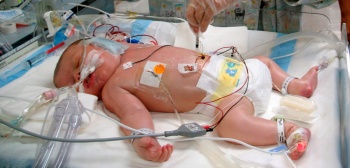
What is dangerous for the baby impaired blood supply to the head
For normal development a child requires that the volume of incoming blood in relation to the brain tissue be 50% more than that of an adult. Deviations from the norm are reflected in mental development.The complexity of therapy lies in the fact that when prescribing drugs that improve blood circulation in the vessels of the brain, the doctor must take into account the effect medicines on the still fragile structures of the child's life: the gastrointestinal tract, nervous system etc.
The consequence of a lack of blood supply is:
- Weak concentration.
- Problems in learning.
- Borderline intellectual disability.
- The development of hydrocephalus and cerebral edema.
- Epilepsy.
How to check the blood supply to the brain
Suspicions of insufficient blood supply to the brain tissue arise in the presence of neurological symptoms and violations. To identify risk factors and prescribe necessary therapy, spend additional examination using instrumental methods for studying blood circulation: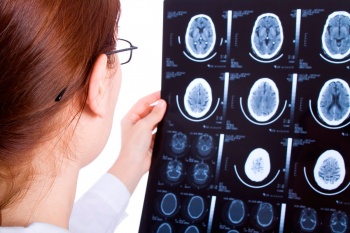
Any drugs, tablets, injections and other medicines are prescribed only after complete examination the patient and determining the problem that affected the deterioration of the blood supply to the brain.
How and how to improve cerebral circulation
According to the results diagnostic study are selected medical preparations that improve cerebral circulation. Since the cause of violations are the most different factors, the course of therapy for one patient may not coincide with what is prescribed for another patient.What improves blood circulation, what drugs
There is no one medicine to improve the circulation of the brain that can eliminate disorders. With any deviation, a course of therapy is prescribed, which includes one or more drugs of the following groups: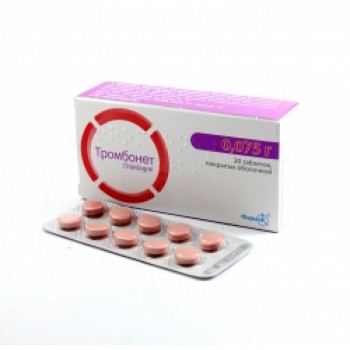
Some drugs have a special purpose. So, cortexin, in the form intramuscular injections, it is recommended to use during pregnancy and after the birth of a child with pronounced encephalopathy. Emoxipin is used for internal bleeding. Available in the form of intravenous injections.
New generation drugs are constantly appearing that have a smaller number of negative side effects. Appoints drug therapy solely the attending physician. Self-medication is strictly prohibited!
How to improve blood flow without drugs
On initial stage It is possible to improve the blood supply to the brain without the help of drugs. There are several ways to influence a person's well-being:
It would be useful to include in therapy the intake of vitamins E and C, which increase blood flow, as well as visit a nutritionist in order to select an effective therapeutic diet.
Folk remedies to improve blood supply to the brain
Treatment of circulatory disorders of the brain folk remedies does not eliminate the need for professional medical care. Non-traditional methods Therapy relieves the symptoms of disorders well:
Herbs that improve blood flow can cause bleeding. Before taking herbal tinctures it is recommended to consult with your doctor.
Breathing exercises to improve circulation
A set of exercises is aimed at enriching the blood with oxygen. There are several types of breathing exercises.Like any effective remedy, exercise without proper supervision and preparation can be dangerous. The first lessons should be carried out together with the instructor.
Breathing exercises are present in yoga and other oriental gymnastics. Effective Methods were developed by compatriots. So, the Streltsova method deserves special mention, which allows you to quickly restore lost brain functions.
Exercises and gymnastics
Exercise therapy to improve the patient's well-being is aimed at the source-catalyst of the problem. During classes, blood pressure and work of the heart are normalized. vascular system.Optimum fit the following types gymnastics:
- Yoga.
- Qigong.
- Pilates.
- Pool activities, swimming.
Diet for poor cerebral circulation
We are what we eat! Life itself proves the veracity of this statement. A person's diet, eating habits have a negative or positive influence to the blood supply to the brain.What foods improve blood flow
Products that improve blood counts include:- Fatty fish.
- Seafood.
- Dairy products.
- Vegetables and fruits, especially rich in iron vitamins.
Food that is harmful to the blood supply to the brain
In case of poor circulation of blood flow, rich in and saturated fatty acids products.The following are subject to the ban:
- Sugar.
- Sweets and flour products.
- Smoked and fatty foods.
- Flavoring additives and synthetic seasonings.
- Carbonated and alcoholic drinks.
Alcohol and cerebral circulation
Moderate doses of alcohol have a beneficial effect on the blood supply to the brain, preventing blockade blood vessels. It's about about small or moderate portions.Alcohol abuse is detrimental to a person. At prolonged abuse high risk of developing hemorrhagic stroke leading to death.
According to a recent study published in Stroke: Journal of the American Heart Association, moderate consumption improves blood flow, while excessive consumption causes brain cells to atrophy.
Correct functioning human body directly depends on the general condition of the circulatory system. If for any reason the blood circulation of an organ is disturbed, the tissues do not receive the required amount of oxygen and nutrients, as a result of which hypoxia develops and metabolic processes slow down, which leads to various diseases.
Circulatory disorders are a certain condition of the cardiovascular system, in which it is not able to provide organs and tissues with adequate blood supply. Ensuring normal blood flow is quite difficult process, depending on the integrity of the vasculature, the correct functioning of the heart and the exact balance between these two systems.
Circulatory disorders, heart failure, decompensation, circulatory disorders - these concepts are completely identical and carry quite broad sense, which refers not only to violations in contractile function myocardium, but also about those arising on the periphery pathological changes which largely determine the patient's condition.
The circulatory system is conditionally divided into peripheral and central.
Pathologies central system blood circulation is caused by disturbances in the work of the heart or in large vessels.
Pathologies in peripheral system blood circulation, are manifested by such main forms:
- blood disorders;
- violations rheological properties blood;
- violations of the permeability of the walls of blood vessels.
Allocate acute circulatory disorders and chronic.
Reasons for the development of the disease
Allocate a sufficient number of causes that can significantly affect the state of the cardiovascular system and cause various violations circulation. Conventionally, all causes are divided into five groups:
- compression;
- traumatic;
- vasospastic;
- associated with the occurrence of tumors;
- occlusal.
Often, circulatory disorders occur in people with certain diseases such as hypertension, diabetes, kidney failure and etc.
Conditions for the development of circulatory disorders, as a rule, are penetrating injuries, vascular disorders, aneurysms, Raynaud's phenomenon.
Treatment of circulatory disorders directly depends on determining the cause with which it is directly related.
Symptoms of circulatory disorders
The clinical manifestations of the disease are varying degrees severity, from preclinical, hidden form when the symptoms of circulatory disorders are clearly manifested only after physical exertion, until brightly severe symptoms with severe disorders of the circulatory system.
There are three degrees of severity of clinical manifestations:
- the first stage is characterized by the absence of symptoms at rest. Signs of pathology appear only after exercise. A person has shortness of breath, tachycardia, palpitations even after such loads that the patient could easily cope with before;
- at the second stage, the clinical manifestations of the pathology are moderately expressed and, with treatment and adherence to the regimen, quickly disappear. Shortness of breath, liver enlargement, edema, ascites and others, bright severe symptoms, under the influence of therapy decrease, but do not disappear completely;
- in the third stage, the symptoms of circulatory disorders are very pronounced and are joined by dystrophy and severe exhaustion of the patient. At this stage, therapy is extremely ineffective and there is a question about surgical treatment.
The main symptoms of circulatory disorders are pain, tingling or numbness of the fingers, discoloration of the skin of the fingertips, shortness of breath, ulcers that do not heal, cyanosis, severe fatigue, dizziness, fainting, chest pain, low or high arterial pressure, poor healing wounds.
Types of circulatory disorders
Acute circulatory disorders, as a rule, are the result of lesions of the cardiovascular apparatus, but can also occur against the background of diseases of the central nervous system, profound metabolic disorders, endocrine diseases, and others. pathological conditions. Usually, acute circulatory disorders develop as a result of acute cardiovascular insufficiency or as a result of simultaneous decompensation of the vascular system and myocardial functions.
Chronic circulatory disorders develop gradually against the background of a decrease in the diameters of blood vessels, up to their complete blockage. obliterating diseases can affect various main vessels, But special meaning given to vascular damage lower extremities, because exactly given reason may cause necrosis. Common to all pathological conditions is the development of chronic arterial insufficiency, which is manifested by ischemic syndrome.
Diagnosis and treatment of circulatory disorders
Diagnosis of circulatory disorders includes whole line instrumental and laboratory research methods. For diagnosis, the presence of any vascular disease and availability characteristic complaints patient. Laboratory methods examinations include blood tests - general, coagulogram, sugar, lipidogram. Such instrumental methods like an MRI duplex scanning. Obligatory examination of the oculist, which allows to determine the signs of angiopathy and conduct a neuropsychological study to identify cognitive impairment.
Treatment of circulatory disorders begins with the identification and treatment of the cause with which it is associated. All therapeutic techniques are divided into conservative and operational. Circulatory disorders in the early stages are not so difficult to cure by resorting to adequate therapy, and sometimes simply by changing your lifestyle, the main thing is not to ignore the clinical manifestations and start therapy on time. healthy eating, a diet low in salt and fat, and high content vitamin E and omega-3, regular exercise, avoiding bad habits combined with the necessary medicines, will have effective impact for the disease.
4.14 out of 5 (14 Votes)Sign up for an appointment with the doctor
Circulatory disorders - a change that is formed as a result of a change in the volume and properties of blood in the vessels or from hemorrhage. The disease has a general and local character. The disease develops from, and bleeding. Impaired blood circulation can be noted in any part of the human body, so there are a lot of reasons for the onset of the disease.
Etiology
The causes of circulatory disorders are very similar in their manifestations to. Often the provoking factor is the deposition of fatty components in the walls of blood vessels. At large cluster of these fats, there is a violation of blood flow through the vessels. This process leads to clogging of the opening of the arteries, the appearance of aneurysms, and sometimes to rupture of the walls.
Conventionally, doctors divide all the causes that disrupt blood circulation into the following groups:
- compression;
- traumatic;
- vasospastic;
- based on tumors;
- occlusal.
Most often, pathology is diagnosed in people with diabetes, and other ailments. Also, circulatory disorders are often manifested from penetrating injuries, vascular disorders, aneurysms and .
Studying the disease, the doctor must determine exactly where the violation is localized. If circulatory disorders are caused in the limbs, then, most likely, the following indicators served as the reasons:
- damage to the arteries;
- cholesterol plaques;
- blood clots;
- spasms of the arteries.
The disease is often provoked by characteristic diseases:
- diabetes;
Circulatory disorders of the lower extremities progress under the influence of certain factors - nicotine, alcohol, excess weight, elderly age, diabetes, genetics, failure in lipid metabolism. Causes of poor blood transport in the legs are General characteristics. The disease develops in the same way as in other places, from damage to the structure of the arteries, a decrease in the lumen of the vessels due to the appearance of plaques, inflammatory process walls of arteries and from spasms.
Etiology of the disorder cerebral circulation lies in the development of atherosclerosis and hypertension. Sharp increase pressure affects the structure of the arteries and can provoke a rupture, which leads to an intracerebral hematoma. Also contribute to the development of the disease can mechanical damage skulls, .
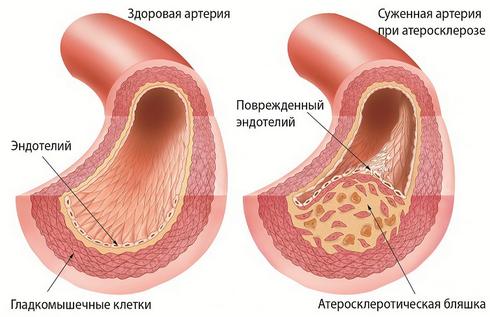
Provoking factors of cerebrovascular accident are the following factors:
- constant fatigue;
- stress;
- physical stress;
- the use of contraceptives;
- excess weight;
- the use of nicotine and alcoholic beverages.
Many ailments manifest themselves in girls during pregnancy, when the body changes significantly, is disturbed hormonal background and authorities need to adjust to new job. During this period, women can detect a violation of the uteroplacental circulation. The process develops against the background of a decrease in the metabolic, endocrine, transport, protective and other functions of the placenta. Because of this pathology, placental insufficiency develops, which contributes to impaired exchange process between the mother's organs and the fetus.
Classification
To make it easier for doctors to determine the etiology of the disease, they brought out such types of common acute disorders blood circulation in cardiovascular system:
- disseminated intravascular coagulation;
- state of shock;
- arterial plethora;
- thickening of the blood;
- venous plethora;
- acute anemia or chronic form pathology.
Local violations venous circulation appear in the following types:
- thrombosis;
- ischemia;
- heart attack;
- embolism;
- blood stasis;
- venous plethora;
- plethora in the arteries;
- bleeding and hemorrhage.
Also presented by doctors general classification diseases:
- acute violation - manifests itself sharply in two types - hemorrhagic or ischemic stroke;
- chronic - develops gradually from acute attacks, manifested in rapid fatigue, headaches, dizziness;
- transient disorder cerebral circulation - characterized by numbness of parts of the face or body, seizures of epilepsy, a violation may occur speech apparatus, weakness in the limbs, pain syndrome, nausea.
Symptoms
Common symptoms of the disease include pain attacks, change in the shade of the fingers, the appearance of ulcers, cyanosis, swelling of the vessels and the area around them, fatigue, fainting and much more. Every person who has ever encountered such problems has repeatedly complained to the doctor about such manifestations.
If we disassemble the disease according to the location of the lesion and its symptoms, then cerebrovascular accidents in the first stage do not manifest themselves. Signs will not bother the patient until there is a strong blood supply to the brain. Also, the patient begins to show such symptoms of circulatory disorders:
- pain syndrome;
- impaired coordination and visual function;
- noise in the head;
- decrease in the level of working capacity;
- violation of the quality of the memory function of the brain;
- numbness of the face and limbs;
- failure in the speech apparatus.
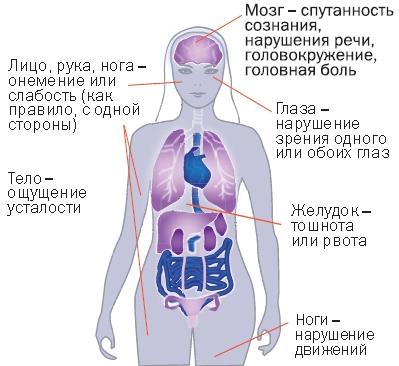
If there is a violation of blood circulation in the legs and arms, then the patient develops severe lameness with pain syndrome and loss of sensation. The temperature of the extremities is often slightly reduced. The person may be disturbed constant feeling heaviness, weakness and convulsions.
Diagnostics
IN medical practice many techniques and methods are used to determine the cause of the violation peripheral circulation(PNMK). Doctors prescribe an instrumental examination to the patient:
- UZ duplex study vessels;
- selective contrast phlebography;
- scintigraphy;
- tomography.
To establish factors that provoke circulatory disorders of the lower extremities, the doctor conducts an examination for the presence of vascular pathologies, and also recognizes all the signs, the presence of other pathologies, general state, allergies, etc. for anamnesis. For precise setting The diagnosis is prescribed by laboratory methods:
- general blood test and sugar;
- coagulogram;
- lipidogram.
In the examination of the patient, it is still necessary to determine the functionality of the heart. For this, the patient is examined using an electrocardiogram, echocardiography, phonocardiography.
In order to determine the functionality of the cardiovascular system as accurately as possible, the patient is examined with physical activity, with breath holding and with orthostatic tests.
Treatment
Symptoms and treatment of circulation are interrelated. Until the doctor reveals to which disease all the signs belong, it is impossible to prescribe therapy.
The best result of treatment will be in the patient whose pathology was diagnosed in the initial stages and therapy was started on time. In eliminating the disease, doctors resort to both medical methods, as well as operational ones. If the disease is detected at the initial stage, then you can be cured by the usual revision of the way of life, balancing nutrition and playing sports.
Treatment of impaired blood circulation is prescribed to the patient according to the following scheme:
- elimination of the root cause;
- promotion contractility myocardium;
- adjustment intracardiac hemodynamics;
- improvement of cardiac work;
- oxygen therapy.
![]()
Methods of therapy are prescribed only after the source of the development of the pathology is identified. If there is a violation of the blood circulation of the lower extremities, then the patient needs to use drug therapy. The doctor prescribes drugs to improve vascular tone and capillary structure. To cope with such goals, such drugs can:
- venotonics;
- phlebotropic;
- lymphotonics;
- angioprotectors;
- homeopathic tablets.
In order to additional therapy doctors prescribe anticoagulants and anti-inflammatory nonsteroidal drugs and hirudotherapy is also used.
If necessary, the patient is provided with prompt assistance - angioplasty or open surgery. Angioplasty is performed using several punctures in the groin, a small catheter with a balloon is inserted into the artery. When the tube reaches the site of blockage, a special balloon expands, which increases the lumen in the artery itself and blood flow is restored. A special stent is installed on the damaged area, which is preventive measure to relapse. The same procedure can be carried out with the defeat of other parts of the body.
Prevention
In order not to provoke a violation of spinal circulation or blockage of blood vessels in any other part of the body, doctors recommend following simple preventive rules:
- for people with sedentary work, it is advisable to exercise regularly with light physical activity. Sports in a person's life should be not only in the evening, but also during the day. People with a sedentary lifestyle need to take a break from work every few hours and do some exercises to improve blood circulation throughout the body. Thanks to such measures, the work of the brain also improves;
- it is important to maintain a normal weight category for men and women. To do this, you need to adjust the diet, add to the diet fresh vegetables, fruits, fish, dairy products. It is better to exclude smoked products from the menu, fatty foods, yeast products, an excessive amount of sweets;
- smoking and alcohol are contraindicated;
- the use of drugs by pregnant women to improve blood circulation in the placenta.
Also, the disease can be prevented by careful attitude to the cardiovascular system, therapy of infectious diseases and other pathologies.
"Impaired circulation" is observed in diseases:
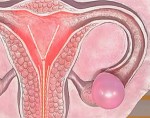
Ovarian apoplexy is a sudden rupture (that is, a violation of the integrity) that forms in the tissue of the ovary. Ovarian apoplexy, the symptoms of which are bleeding, turning into abdominal cavity, in addition to this, it is accompanied by an intense pain syndrome.
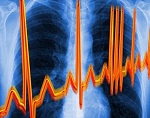
Arrhythmia implies all those conditions in which the sequence of heart contractions, their frequency and strength, as well as rhythm are subject to change. Arrhythmia, the symptoms of which are manifested due to a violation of the main functions inherent in the heart (conductivity, excitability, automatism), is in one name a generalized version of the pathology, which means any changes in the heart rhythm that are different from the standard sinus rhythm.

Vasomotor rhinitis is a violation that occurs during nasal breathing, which in particular is facilitated by a constriction that forms in the nasal cavity. Vasomotor rhinitis, the symptoms of which are provoked by swelling of tissues in the turbinates in this process, also causes disturbances in vascular tone, as well as vascular tone in the nasal mucosa.

Thoracic osteochondrosis, which we will consider today in our article, is one of the varieties of the manifestation of osteochondrosis - a disease of the spine, as a result of which intervertebral discs with cartilage in the corresponding area of its concentration. Thoracic osteochondrosis, the symptoms of which are based on the concentration in the area thoracic, stimulates the development secondary changes directly in the vertebrae with simultaneous negative impact to the work of internal organs.

